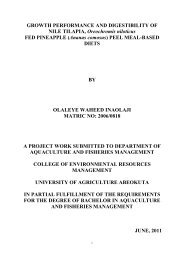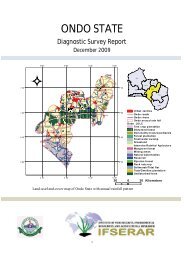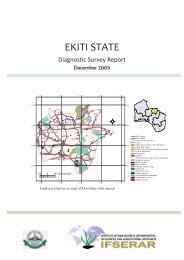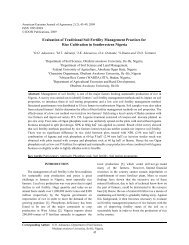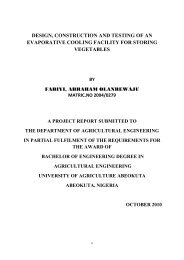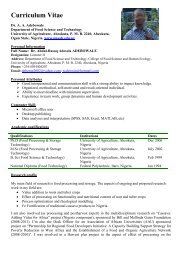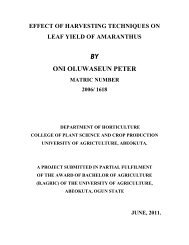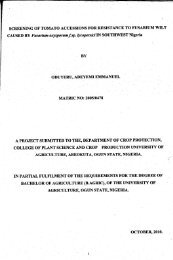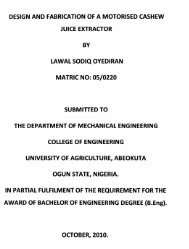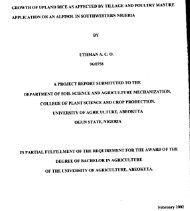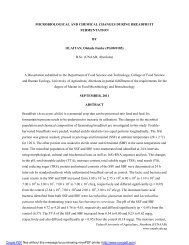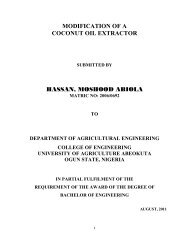EFFECT OF BROMATE ON THE SPECIFIC VOLUME OF BREAD ...
EFFECT OF BROMATE ON THE SPECIFIC VOLUME OF BREAD ...
EFFECT OF BROMATE ON THE SPECIFIC VOLUME OF BREAD ...
You also want an ePaper? Increase the reach of your titles
YUMPU automatically turns print PDFs into web optimized ePapers that Google loves.
<strong>EFFECT</strong> <strong>OF</strong> <strong>BROMATE</strong> <strong>ON</strong> <strong>THE</strong> <strong>SPECIFIC</strong> <strong>VOLUME</strong> <strong>OF</strong> <strong>BREAD</strong><br />
MADE FROM SELECTED COMPOSITE FLOUR.<br />
BY<br />
JOLAOSHO AYOPEJU ELIZABETH<br />
MATRIC NO: 05/0767<br />
A PROJECT SUBMITTED TO <strong>THE</strong> DEPARTMENT <strong>OF</strong> FOOD SCIENCE<br />
AND TECHNOLOGY, UNIVERSITY <strong>OF</strong> AGRICULTURE, ABEOKUTA.<br />
IN PARTIAL FULFILLMENT <strong>OF</strong> <strong>THE</strong> REQUIREMENT FOR <strong>THE</strong><br />
AWARD <strong>OF</strong> BACHELOR <strong>OF</strong> SCIENCE.<br />
UNIVERSITY <strong>OF</strong> AGRICULTURE, ABEOKUTA, OGUN STATE.<br />
OCTOBER, 2010.
ABSTRACT<br />
The study investigated the effect of bromate on the specific volume of bread baked from<br />
cassava-wheat, maize-wheat, soy-wheat composite flour and wheat flour. The baking<br />
temperature adopted for this investigation was 200 0 c and the levels of bromate used were 0,<br />
30 ppm, 60 ppm which are equivalent to 0, 0.006 g and 0.012 g respectively.<br />
The linear regression of the specific volume of bread samples which ranged from 1.28-2.08<br />
cm 3 /g against bromate level showed that the specific volume decrease of cassava-wheat bread<br />
samples at the different bromate level ranged from 1.97-1.68 cm 3 /g while for soy-wheat, samples<br />
ranged from 1.59-1.28 cm 3 /g, however, there was increase in specific volume of maize-wheat<br />
bread samples in the range of 1.61-1.73 cm 3 /g. Non-bromated wheat bread samples had an<br />
average specific volume of 2.08 cm 3 /g.<br />
Sample means (n=10) of bromated cassava-wheat bread at 60 ppm and bromated maize-wheat<br />
bread at 30 ppm were not significantly different at p< 0.05. However, there was significant<br />
different between sample means of other bread samples of the flour types at different bromate<br />
level at p< 0.05.
DEDICATI<strong>ON</strong><br />
This project work is dedicated to Holy Spirit my mentor for his direction and to my husband, Mr.<br />
Sanya Ogunjobi for his love which fulfills all laws.
AKCNOWLEDGEMENT<br />
I am very grateful to God for his support, understanding and boundless love love he has<br />
showered on me right from the cradle.<br />
My gratitude also goes to my ever-competent and thorough supervisor, Dr. T.A. Shittu, for his<br />
patience, understanding, encouragement and dedication in the development and execution of this<br />
research work.<br />
I am extremely grateful to my parents particularly my mother who sacrificed everything for her<br />
daughters to get sound education and my father who supported me financially and materially in<br />
the pursuit of my academic career.<br />
To all my lecturers and staffs of the department of food science and technology, I say thank you<br />
for the knowledge they have imparted on me.<br />
Words cannot express my profound gratitude to Mr. Dapo Arowona of Honeywell Flour Mill<br />
Limited for the opportunity I was given to make use of the company’s resources during my<br />
research study.<br />
To all my friends: Kemi, Deola, Doyin, Yinka girl, Titi, Dami, Tallest, Yinka boy, Chuks,<br />
Osagie and my baby………… Dipo. I say thank you to all.<br />
Finally, I am indebted to my loving, caring and dearest husband, Sanya Ogunjobi who believed<br />
in me against all odds. I loved you, I love you and I will always love you.
TABLE <strong>OF</strong> C<strong>ON</strong>TENT<br />
Title Page<br />
i<br />
Certification<br />
ii<br />
Abstract<br />
iii<br />
Dedication<br />
iv<br />
Acknowledgement<br />
v<br />
Table of Content<br />
vi<br />
List of Tables<br />
x<br />
List of Figures<br />
xi<br />
CHAPTER <strong>ON</strong>E 1<br />
1.0 Introduction 1<br />
CHAPTER TWO 3<br />
2.0 Literature Review 3<br />
2.1 Bread 3<br />
2.1.1 Functional Ingredient in Bread 4<br />
2.1.1.1 Flour 4<br />
2.1.1.2 Water 5
2.1.1.3 Yeast 5<br />
2.1.1.4 Salt 5<br />
2.1.1.5 Sugar 5<br />
2.1.1.6 Shortening 6<br />
2.1.1.7 Oxidizing Agent 6<br />
2.2.0 Potassium Bromate 6<br />
2.3.0 Gluten Protein 8<br />
2.4.0 Composite Flour 10<br />
2.4.1 Soya bean Flour 12<br />
2.4.2 Maize Flour 13<br />
2.4.3 Cassava Flour 13<br />
2.5.0 Farinograph Analysis of Flour 14<br />
2.6.0 Alveograph Test 15<br />
2.7.0 Previous Research Work Conducted on Composite Flour 16<br />
CHAPTER THREE 19<br />
3.0 Materials and Method 19<br />
3.1.0 Description of Project Environment 19
3.2.0 Material 19<br />
3.2.1 Wheat Flour 19<br />
3.2.2 Other Flour Substitute 19<br />
3.2.3 Composite Flour Preparation 24<br />
3.3.0 Methods 24<br />
3.3.1 Chemical Composition 24<br />
3.3.2 Functional Properties 24<br />
3.3.2.1 Water Absorption Capacities 24<br />
3.3.2.2 Oil Absorption Capacities 25<br />
3.4.0 Farinograph and Alveograph Analysis 25<br />
3.5.0 Experimental Design 25<br />
3.6.0 Baking Experiment 27<br />
3.7.0 Determination of Physical Parameters 29<br />
3.7.1 Weight, Volume and Specific Volume Measurement 29<br />
3.8.0 Statistical Analysis 29<br />
CHAPTER FOUR 30<br />
4.0 Result and Discussion 30
4.1.0 Chemical Composition of Composite Flours 30<br />
4.2.0 Functional Properties of Flour used as Substitute for Wheat 32<br />
4.3.0 Farinograph Analysis 34<br />
4.4.0 Alveograph Analysis 36<br />
4.5.0 Statistical Analysis of Result 38<br />
CHAPTER FIVE 40<br />
5.0 Conclusion and Recommendation 40<br />
5.1.0 Conclusion 40<br />
5.2.0 Recommendation 40<br />
Reference 41
LIST <strong>OF</strong> TABLES<br />
Table<br />
Page<br />
1. Formulation of Bread Making 26<br />
2. Chemical Composition of Composite Flour 31<br />
3. Functional Properties of Flour Substitute 33<br />
4. Farinograph Data for the Composite Flours 35<br />
5. Alveograph Data for the Composite Flours 37
LIST <strong>OF</strong> FIGURES<br />
Figure<br />
Page<br />
1. Flow Chart for Wheat Flour Milling 20<br />
2. Flow Chart for Cassava Flour Production 21<br />
3. Flow Chart for Soy Flour Production 22<br />
4. Flow Chart for Maize Flour Production 23<br />
5. Flow Chart for the Production of Bread 28<br />
6. Effect of Bromate on the Specific Volume of Bread Produced from Flour Samples 38
CHAPTER <strong>ON</strong>E<br />
1.0 INTRODUCTI<strong>ON</strong><br />
Bread is one of the oldest, yet still most popular food in the world, invented by the Egyptians<br />
some 800 years ago, bread launched as world conquering crusade during olden days of ancient<br />
Greece and Roman Empire (Oyewole et al., 2002). The ever-growing popularity of bread may be<br />
connected with its convenience, high acceptability, high energy content and low level of blood<br />
cholesterol associated with its consumption (Gaman and Sherington, 1981). Water and flour are<br />
the major components in a bread recipe. They affect the bread texture and crumb properties.<br />
Potassium bromate is a flour improver that acts as a maturing agent. It acts principally in the late<br />
dough stage giving strength to the dough during late proofing and early baking (KuroKawo et<br />
al., 1990). Potassium bromated takes the form of white crystals or powder. Potassium bromate<br />
has been used as a dough conditional for the past 60 years. According to USDA, it improves<br />
dough processing properties, internal crumb quality and loaf volume in concentration from a few<br />
to 75ppm, the highest concentration permitted by law. The mechanism by which bromate acts in<br />
dough is complex and not well understood (DeStefanis, 1992).<br />
In early 1990’s, the World Health Organization (WHO) discovered that potassium bromated if<br />
consumed has the capacity to cause such diseases as cancer, kidney failure and several other<br />
related diseases. The use of bromate has been banned in numerous countries. In Nigeria, the<br />
bromated use in bread making was banned in 1993 (Obot et al., 2008).<br />
Composite flours are mixture of flours from tubers rich in starch (e.g. cassava, yam, sweet<br />
potato) and/or protein-rich flours (e.g. soy, peanut) and/or cereals (e.g. maize, rice, millet, buck<br />
wheat), with or without wheat flour. Bread has become the second most widely consumed non-
indigenous food product after rice in Nigeria. Till date, most Nigerians have not been introduced<br />
to other types of bread apart from 100% wheat flour. To cut the nation’s expenses on wheat<br />
importation and find wider utilization for the increasingly produced cassava root the federal<br />
government mandated the use of composite cassava-wheat flour for baking by adding a<br />
minimum of 10% cassava flour to wheat for a start (Shittu et al., 2006). The inclusion of<br />
composite flour into wheat up to 30% could still give an acceptable fresh loaf depending on the<br />
source of flour (Defloor et al., 1993).<br />
Although, the use of potassium is common to poorly wheatened bread, there is not much study to<br />
find out whether similar dough improvement can be derived in composite bread. Adebambo<br />
(2007) studied the effect of baking temperature and bromate on the oven development of<br />
composite cassava-wheat bread by considering 3 factors (time, temperature and bromate level)<br />
i.e. 40 minutes at 5 minute interval, 3 temperature range and 3 levels of bromate. The dough was<br />
prepared in 2 batches, the first batch for non-bromated dough and the second batch for bromated<br />
dough. The study suggested that the use of potassium bromate has a detrimental effect on the<br />
oven development of bread made from composite cassava-wheat flour and the use of higher<br />
baking temperature could reduce loaf size. However, the research work was inconclusive. It is<br />
therefore important to validate this research work.<br />
Therefore, the objective of this study was to validate the previous observation that inclusion of<br />
bromate had negative effects on the loaf property of composite cassava-wheat bread. In addition,<br />
other composite flour systems were also investigated to further establish the truthfulness of the<br />
reported observation. It is hoped that the result of the study will assist in establishing commercial<br />
feasibility of composite flour technology and probably advise bakers on the use of bromate on<br />
composite bread.
CHAPTER TWO<br />
2.0 LITERATURE REVIEW<br />
2.1 <strong>BREAD</strong><br />
Bread is a staple food prepared by cooking a dough of flour and water and possibly more<br />
ingredients. Dough is usually baked, but in some cuisines breads are steamed, fried, or baked on<br />
an unoiled skillet. It may be leavened or unleavened. Salt, fat and leavening agents such as yeast<br />
and baking soda are common ingredients, though bread may contain other ingredients, such as<br />
milk, egg, sugar, spice, fruit (such as raisins), vegetables (such as onion), nuts (such as walnuts)<br />
or seeds (such as poppy seeds). Bread is one of the oldest prepared foods, dating back to the<br />
Neolithic era, and is referred to colloquially as the "Staff of life". The development of leavened<br />
bread can probably also be traced to prehistoric times.<br />
Fresh bread is prized for its taste, aroma, quality and texture. Retaining its freshness is important<br />
to keep it appetizing. Bread that has stiffened or dried past its prime is said to be stale. Modern<br />
bread is sometimes wrapped in paper or plastic film, or stored in a container such as a breadbox<br />
to reduce drying. Bread that is kept in warm, moist environments is prone to the growth of mold.<br />
Bread kept at low temperatures, in a refrigerator for example, will develop mold growth more<br />
slowly than bread kept at room temperature, but will turn stale quickly due to retro gradation.<br />
The soft, inner part of bread is known to bakers and other culinary professionals as the crumb,<br />
which is not to be confused with small bits of bread that often fall off, called crumbs. The outer<br />
hard portion of bread is called the crust (Anonymous, 2010a).
2.1.1 FUNCTI<strong>ON</strong>AL INGREDIENTS IN <strong>BREAD</strong> PRODUCTI<strong>ON</strong><br />
Quality control of your bread production should start with an understanding of what the<br />
ingredients do. Using good technical skills, the baker can manipulate the inconsistencies of<br />
ingredients to produce a uniform, consistent product. When discussing other ingredients, usage<br />
levels are based in comparison to flour. This percentage is called the “Baker’s Percent.” When<br />
using Baker’s Percent, the total flour will always add up to 100%<br />
2.1.1.1 FLOUR<br />
Flour comes from the wheat kernel and yields about 75% flour out of the wheat. White flour<br />
comes from the middle of the kernel. Most formulations yield slightly over 1.5 pounds of bread<br />
for every pound of flour.<br />
Flour is divided into many separate parts. Most of the flour is composed of starch, and this starch<br />
is either undamaged or damaged during the milling process. The damaged starch is fully<br />
hydrated in the dough, but the undamaged (or native) starch cannot fully hydrate until the baking<br />
process. Normal levels of damaged starch are between 6 and 11 percent in bread flours.<br />
Along with fat, sugars and mineral content (ash), flour also has protein in it. This gluten-forming<br />
protein is insoluble in water and forms a rubbery mass when mixed with water. Common<br />
Specifications for flour include:<br />
Moisture (12-14%)<br />
Ash (.45 – .65%)<br />
Protein (10.5 – 13%)
2.1.1.2 WATER<br />
Water is the second main ingredient on the label, and the control of it is important. The main<br />
function of water is hydration. All ingredients must have water to function. The total level of<br />
water in bread dough is normally within the range of 55% to 65%. Water is the least expensive<br />
ingredient in the formulation. However, too much water can dilute a good product.<br />
2.1.1.3 YEAST<br />
Yeast is used in bread dough to provide leavening. The level of usage in most bread is 2 to 5%<br />
compressed yeast. Yeast converts fermentable sugars into carbon dioxide and alcohol in a<br />
reaction called fermentation. Yeast is a living organism and its activity can be influenced by<br />
storage practices. Dry yeasts have a longer shelf life and do not need to be refrigerated. Active<br />
dry yeast must be pre hydrated in5 to 15 minutes before adding to dough in water.<br />
Instant dry yeast can be added without pre hydrating. Compressed and cream yeasts need to be<br />
stored at refrigerated conditions.<br />
2.1.1.4 SALT<br />
The main function of salt is to mask off flavors and bring out good flavor of the baked product.<br />
Usage levels are normally between 1.5 and 2.5%. Salt also inhibits fermentation with a partial<br />
dehydration of the yeast cell. Salt toughens the gluten and strengthens weaker flours.<br />
2.1.1.5 SUGAR<br />
Sugar provides food for the yeast. In a normal bread production process, 3 to 3.5 % fermentable<br />
solids are required to sustain yeast activity. This food supply can come from added sugar, from
conversion of starches to sugars, or a combination of both. As residual sugar levels are higher,<br />
crust color is darker, taste is sweeter, and moisture retention is improved.<br />
The most common sugar is high fructose corn syrup (42% of the solids in the syrup are fructose).<br />
When storing syrups, it is important to keep the temperature slightly warm (around 85 degrees<br />
Fahrenheit). If the syrup gets cold, it will crystallize during storage. If it gets too hot, it will<br />
darken or caramelize. Usage levels for sugars range from 0 to 15%.<br />
2.1.1.6 SHORTENING<br />
Shortening is used in bread production to provide overall lubrication. It is necessary to use a<br />
small amount to facilitate slicing. It is recommended to use a minimum of .7 to 1% for good<br />
slicing (although some bakers use less that this on low-calorie breads. Shortening also lubricates<br />
the dough to ease dough expansion. It also tenderizes the crust and improves shelf life. Normal<br />
usage levels are 0 to 5%. White pan bread usage between 1.5 and 3%. The most commonly used<br />
shortening is soybean oil. Most bakers have removed all animal fate such as lard and butter from<br />
formulations to that no cholesterol is on the label.<br />
2.1.1.7 OXIDIZING AGENTS<br />
Oxidizing agents are used by the baker to improve dough strength by creating bonds between the<br />
protein chains. They will improve dough handling for better machining and contribute to<br />
improved gas retention giving better volume and tighter grain to the finished product. Some<br />
oxidants are fast acting, working in the mixer and early make-up stage, while ascorbic acid is late<br />
acting, working in the proofer and early oven stage (Anonymous, 2010b).
2.2.0 POTASSIUM <strong>BROMATE</strong><br />
The major challenge in both the flour milling industries and bakeries is the baking quality of<br />
flour, which is determined by the capacity of the dough prepared from it to retain gas. As a result<br />
of world wide variation in the composition of flour, various treatments and supplements or<br />
conditioning agents (flour/bread improvers) are added for strength during mixing, extensibility<br />
for molding and also to increase loaf volume and texture.<br />
Over the years, several improvers have been used but studies have shown some to be deleterious<br />
to health, thereby necessitating the ban. The use of potassium bromate has been a common<br />
choice among flour millers and bakers throughout the world because it is cheap and probably the<br />
most efficient oxidizing agent. However, concern has been expressed on the harmful effects of<br />
potassium bromated. Toxicological studies have convincingly shown that potassium bromated<br />
affects the nutritional quality of bread by degrading vitamins A, B1, B2, E and niacin, the main<br />
vitamins in bread. Also, studies have shown significant differences in essential fatty acid content<br />
of flour treated with bromated or in bread made from such flour.<br />
The British Food Manufacturing Industries Research Association reported in 1980 that<br />
potassium bromate destroys folic acid in 10 days. It was reported by the International Chemical<br />
Safety Cards (ICSC) that potassium bromated on inhalation can cause cough and sore throat in<br />
human whereas on ingestion, it causes abdominal pain, diarrhea, nausea, vomiting, kidney<br />
failure, hearing loss, as well as redness and pain both in eyes and skin.<br />
Bromate has since been banned and removed from list of improvers generally regarded as safe<br />
(GRAS) ingredients by the FAO/WHO Expert Committee on Food Additives worldwide since
1992. In Nigeria, use of potassium bromated in flour milling and baking has been banned by<br />
NAFDAC since 1993.<br />
Apart from potassium bromate, other improvers that are injurious to health include nitrogen<br />
trichloride and ammonium persulphate. Nitrogen trichloride destroys the flour pigment and<br />
reacts with methionine residue of the gluten protein forming methionine sulphoxine, which<br />
causes brain disturbances in animal. Like most substances with chlorine as active ingredient, it<br />
depletes the vitamin content of flour (vitamins A, E and B-complex). Ammonium Persulphite<br />
has a depleting effect on the vitamin content of flour and causes skin allergy (Bakers Eczema).<br />
2.3.0 GLUTEN PROTEIN<br />
There is no way we can understand the action of potassium bromate on the gluten protein in<br />
wheat without having a broad knowledge of the structure and composition of gluten. Gluten can<br />
be defined as the rubbery mass that remains when wheat dough is washed to remove starch<br />
granules and water-soluble constituents. Depending on the thoroughness of washing, the dry<br />
solid contain 75–85% protein and 5–10% lipids; most of the remainder is starch and nonstarch<br />
carbohydrates. In practice, the term ‘gluten’ refers to the proteins, because they play a key role in<br />
determining the unique baking quality of wheat by conferring water absorption capacity,<br />
cohesivity, viscosity and elasticity on dough. Gluten contains hundreds of protein components<br />
which are present either as monomers or, linked by interchain disulphide bonds, as oligo- and<br />
polymers (Wrigley and Bietz, 1988). They are unique in terms of their amino acid compositions,<br />
which are characterized by high contents of glutamine and proline and by low contents of amino<br />
acids with charged side groups. The molecular weights (MWs) of native proteins range from<br />
around 30,000 to more than 10 million. Traditionally, gluten proteins have been divided into<br />
roughly equal fractions according to their solubility in alcohol–water solutions of gluten (e.g.
60% ethanol): the soluble gliadins and the insoluble glutenins. Both fractions are important<br />
contributors to the rheological properties of dough, but their functions are divergent. Hydrated<br />
gliadins have little elasticity and are less cohesive than glutenins; they contribute mainly to the<br />
viscosity and extensibility of the dough system. In contrast, hydrated glutenins are both cohesive<br />
and elastic and are responsible for dough strength and elasticity. To simplify matters, gluten is a<br />
‘two component glue’, in which gliadins can be understood as a ‘plasticizer’ or ‘solvent’ for<br />
glutenins. A proper mixture of both fractions is essential to impart the viscoelastic properties of<br />
dough and the quality of the end products. Though cysteine belongs to the minor amino acids of<br />
gluten proteins (E2%), it is extremely important for the structure and functionality of gluten<br />
(Grosch and Wieser, 1999). Most cysteines are present in an oxidized state and form either<br />
intrachain disulphide bonds within a protein or interchain disulphide bonds between proteins.<br />
These bonds are the main target for most redox reactions that occur during kernel maturation,<br />
milling, dough preparation and baking. Additional covalent bonds formed during break making<br />
are tyrosine–tyrosine crosslink between gluten proteins (Tilley et al., 2001) and tyrosine–<br />
dehydroferulic acid cross links between gluten proteins and arabinoxylans (Piber and Koehler,<br />
2005). The covalent structure of the gluten network is superimposed by non-covalent bonds<br />
(hydrogen bonds, ionic bonds, hydrophobic bonds). Though this class of chemical bonds is less<br />
energetic than covalent bonds, they are clearly implicated in gluten protein aggregation and<br />
dough structure (Wieser et al., 2006). Evidence for the presence of hydrogen bonds in gluten<br />
proteins are the dough weakening effect of hydrogen bond breaking agents (e.g. urea) and the<br />
dough strengthening effect of heavy water compared with that of ordinary water. The importance<br />
of ionic bonds can be demonstrated by the strengthening effect of NaCl or of bipolar ions such as<br />
amino acids or dicarboxylic acids. Hydrophobic bonds contribute significantly to the<br />
stabilization of gluten structure. They are different from other bonds, because their energy
increases with increasing temperature; this can provide additional stability during the baking<br />
process (Wieser, 2006).<br />
2.4.0 COMPOSITE FLOUR<br />
In the 1960s and 1970s, composite flours very often found themselves at the focus of attention in<br />
European and international cereal research. Most studies in this field were supported by FAO<br />
(Food and Agricultre Organization of the United Nation. In two decades, bread consumption<br />
increased continuously in many of the developing countries. There were three main reasons for<br />
this:<br />
<br />
<br />
<br />
A steady growing population;<br />
Changes in eating habits;<br />
An overall increase in income, which meant that a larger proportion of the income could<br />
be spent on food.<br />
In most cases the wheat or wheat flour needed for making bread, rolls and pastry goods had to be<br />
imported, since the climatic conditions and soil did not permit wheat to be grown locally, or<br />
made it very difficult. In these developing countries the imports of wheat had an increasingly<br />
adverse effect on the balance of trade. For these reasons the FAO and these developing countries<br />
were interested in the possibility of replacing the wheat needed for making baked goods, and also<br />
pasta, wholly or partly with flour obtained from home-grown products. Possible sources were<br />
tuberous plants rich in starch such as cassava, yam, sweet potatoes, protein-rich flour such as soy<br />
and peanut and other cereals including maize, rice, millet and sorghum.
Although, it is well known that no other crops can achieve the baking properties of wheat,<br />
composite flours became the subject of numerous studies. For the developing countries, the use<br />
of composite flour had the following advantages:<br />
<br />
<br />
<br />
<br />
A saving of hard currency;<br />
Promotion of high-yielding, native plant species;<br />
A better supply of protein for human nutrition;<br />
Better overall use of domestic agriculture production<br />
Composite flours are quite different from the ready-mixed flours familiar to miller and bakers.<br />
Whereas ready-mixed flours contain all non-perishable constituent of the recipe for a certain<br />
baked product, composite flour are only a mixture of different vegetable flours rich in starch or<br />
protein, with or without wheat flour, for certain groups of bakery products.<br />
The use of composite flour with or without wheat gives rise to technical problems in the<br />
production of baked goods. From the baker’s point of view, the most important component of<br />
wheat flour is the protein of the gluten, which plays a decisive role in dough formation, gas<br />
retention and the structure of the crumb.<br />
Most of the trials of composite flour have been carried out in Africa because of Africa’s<br />
continually growing population. In the bread sector, the task was to produce typical French bread<br />
with composite flour. The proportion of wheat flour in the different mixtures varied greatly, the<br />
maximum being 70%. Because of the difficulty of keeping bread fresh, a great many experiment<br />
were carried out with composite flour in biscuit production. So far there are no reports that bread<br />
and biscuit have been produced from composite flour to any appreciable extent in an African<br />
country. In spite of the lower price, the population is often disinclined to buy such bread because<br />
of its unfamiliar flavor and its chewing properties, which differ from those of ordinary white
ead. Moreover, there are persistent rumors that many institutions profit financially from import<br />
of wheat, and this would not be the case if locally-grown raw materials were used.<br />
On 1 January 2005 Nigeria enacted a directive that makes the addition of 10% cassava flour to<br />
wheat flour mandatory in order to support the local cassava crops and reduce exports of hard<br />
currency. Unfortunately, cassava has already been a staple food for the very poor. Since the local<br />
grower of cassava roots can by no means satisfy the theoretical demand of flour mills, at least a<br />
temporary shortage with price increase is likely. Moreover, the available cassava flour qualities<br />
differ greatly, for example in colour, taste and cyano-glycoside content. So it is still not certain<br />
whether this initiative will soon result in the long-term use of cassava flour in wheat flour<br />
(Anonymous, 2010c).<br />
2.4.1 SOYA BEAN FLOUR<br />
This finely ground flour is made from soybeans and, unlike many flours, is very high in protein<br />
(twice that of wheat flour) and low in carbohydrates. Soy flour is ordinarily mixed with other<br />
flours rather than being used alone. It has a wide variety of uses such as for baking and to bind<br />
sauces. Soy flour can be defatted soybeans ground finely enough to pass through a 100-mesh or<br />
smaller screen where special care was taken during desolventizing (not toasted) in order to<br />
minimize denaturation of the protein to retain a high Protein Dispersibility Index (PDI), for uses<br />
such as extruder cooking of textured vegetable protein. It is the starting material for production<br />
of soy concentrate and soy protein isolate. Defatted soy flour is obtained from solvent extracted<br />
flakes, and contains less than 1% oil. Full-fat soy flour is made from unextracted, dehulled<br />
beans, and contains about 18% to 20% oil. Due to its high oil content a specialized Alpine Fine<br />
Impact Mill must be used for grinding rather than the more common hammer mill. Low-fat soy
flour is made by adding back some oil to defatted soy flour. The lipid content varies according to<br />
specifications, usually between 4.5% and 9%. High-fat soy flour can also be produced by adding<br />
back soybean oil to defatted flour at the level of 15%. Lecithinated soy flour is made by adding<br />
soybean lecithin to defatted, low-fat or high-fat soy flours to increase their dispersibility and<br />
impart emulsifying properties. The lecithin content varies up to 15%.<br />
2.4.2 MAIZE FLOUR<br />
Maize flour is to Africans what wheat and potato flours are to Europeans and Americans. It is<br />
harvested from the cub of the popular maize or corn plant, known botanically as Zea mays. It is<br />
traditionally produced by pounding maize in a big mortar until a smooth powder is obtained.<br />
Maize flour from the maize seed is now produced in very large scale by mechanization through<br />
modern technology. Maize flour can be used exactly as wheat flour in making bread,<br />
confectioneries, breakfast meals and more. Maize flour, also called corn flour is highly rich in<br />
protein, dietary fibre and very low in fat. Maize or corn flour is by far the most widely eaten<br />
flour after wheat and rice flour. It is uniquely rich in dietary fibre, protein, vitamin B6,<br />
magnesium and omega 6 oils, vital for good heart, optimal bowel functions and fight against<br />
infections. Fortified maize or corn flour has been used in the eradication of malnutrition in some<br />
parts of the world.<br />
2.4.3 CASSAVA FLOUR<br />
Cassava flour is becoming a welcome ingredient in many food products, especially in Latin<br />
American countries. In Africa, these potentials are still being explored especially in Nigeria<br />
where technology for incorporation of 10% cassava flour in composite flour formulation has<br />
proved successful. This development prompted the Federal Government to start working on the
legislation by the National Assembly of including cassava flour into composite flour formulation<br />
starting from January 2005. It is projected that if Nigeria imported 3,390,000 MT of wheat/<br />
wheat flour in 2003 chiefly for the bakery and related industry, then by January 2005, it is<br />
expected that 339,000 MT of High Quality Unfermented Cassava Flour (HQUCF) will be<br />
required by this sector of economy. Hence, opportunities thus exist for the investments of<br />
HQUFC.<br />
2.5.0 FARINOGRAPH ANALYSIS <strong>OF</strong> FLOUR<br />
Farinograph determines the dough and gluten characteristics of flour by measuring the resistance<br />
of the dough made from such flour against the mixing action of mixing blades. Farinograph test<br />
is one of the most commonly used flour quality test in the world. The result are used as<br />
parameters in the formulation to estimate the amount of water required to make a dough, to<br />
predict the processing effect including mixing requirement for dough development, tolerance of<br />
dough to over mixing and dough consistency during production. The results are also useful in<br />
predicting finished product texture characteristics e.g. dough mixing properties are related to<br />
firm texture.<br />
Results obtainable from Farinogram include water absorption capacity, which this is the amount<br />
of water required to center the farinograph curve on the 500-brabender unit (BU) line. It relates<br />
to the amount of water needed for a flour to be optimally processed into end products. It is<br />
expressed as a percentage.<br />
Peak time: it indicates dough development time beginning from the moment water was added<br />
until the dough reaches a maximum consistency before gluten strands begin to break. It is the<br />
highest point on the curve and it is expressed in minute.
Arrival time: the time when the top of the curve touches the 500 BU- line. It indicates the rate of<br />
hydration.<br />
Departure time: this is the time when the top of the curve leaves the 500-BU line. It indicates the<br />
time when the dough is beginning to break down<br />
Mixing tolerance index: the difference in BU at the top of the curve at peak time and the value at<br />
the top of the curve 5 minutes after peak.<br />
Degree of softening: the difference in BU between line of the consistency and the medium line of<br />
the torque curve 12 minutes after weakening begins (AACC, 2000).<br />
2.6.0 ALVEOGRAPH ANALYSIS<br />
Alveograph test was conducted on the composite flour in order to determine the dough<br />
extensibility and resistance of the dough to deformation so as to have the knowledge of the<br />
suitability of the flour for baking purpose. Alveograph is a measure of the amount of air bubble<br />
dough can hold before it burst. It measures the dough strength and extensibility. It is represented<br />
by the total area under the alveogram.<br />
Generally, the higher the dough strength, the better the flour quality. The dough extensibility (L)<br />
is a measure of the elastic property of the dough and its stability to enjoy pan flow. The height of<br />
the alveogram (Pmax) tells us the ability of the dough to withstand pressure. The P/L<br />
(extensibility ratio) is a very important factor than either P or L function. The lower the ratio, the<br />
better the flour.
2.7.0 PREVIOUS RESEARCH WORK C<strong>ON</strong>DUCTED <strong>ON</strong> COMPOSITE <strong>BREAD</strong><br />
Chi-Lin et al. (2004) conducted a research study on the quality and antioxidant property of bread<br />
as affected by the incorporation of yam flour in the formulation. It was concluded that, bread<br />
made with 5% of yam flour in the formulation did not show a significant difference in loaf<br />
volume when compared with the control bread without yam flour. Bread made with 20% yam<br />
flour substitution had a loaf volume that was reduced to 71% of bread without yam flour.<br />
Moreover, the 25% substitution not only reduced the loaf volume to 54% but also resulted in<br />
irregularly shaped bread. Loaf volume is one of the major quality indicators for bread and is<br />
influenced by many factors including wheat flour compositions, additives and dough<br />
fermentation conditions; regard to loaf volume, the highest ratio of yam flour to wheat flour in<br />
the bread formulation should not exceed 20%. The effects of the ratio of yam flour : wheat flour<br />
on the loaf height were similar to those effects on loaf volume. While 5% substitution showed no<br />
significant difference, 25% substitution reduced loaf height to 62.8% of that shown by bread<br />
without yam flour. As less wheat gluten in the formulation may retain less fermentation gas, this<br />
may be the primarily reason for the decline in both loaf volume and height in bread containing<br />
yam flour.<br />
In 2007, Dimitrios et al. conducted a study on the effect of rice, soy and corn flour addition on<br />
the characteristics of bread produced from different wheat cultivars. It was found that<br />
supplementation of bread wheat flour with rice, corn, and soy flour up to 10% and durum wheat<br />
flour up to 20% levels produced dough with satisfactory rheological properties and bread with<br />
acceptable quality attributes (color, taste, and flavor). In contrast, as the level of inclusion<br />
increases above 20% bread quality characteristics deteriorated proportionally, (low loaf volume,<br />
lack of flavor, black specks, coarse crumb, hard texture) as a result of the replacement of gluten
y the added protein. The key factor in producing acceptable breads is gluten structure of the<br />
flour, and this is the reason why the use of Greek durum wheat flour results in better bread<br />
making potential and longer shelf life than bread wheat flour.<br />
Olaoye et al. (2006) studied the quality characteristics of bread produced from composite wheat<br />
plantain and soya bean. It was concluded that breads produced with soy flour substitution, up to<br />
15%, were nutritionally superior to that of the whole wheat flour. Breads of good nutritional and<br />
sensory qualities could be produced from up to 10% soy flour substitution in wheat flour. The<br />
nutritional qualities and sensory attributes of plantain flour substituted breads are comparable to<br />
that of the whole wheat. It is recommended that up to 15% plantain flour substitution could be<br />
adopted in bread making processes, without affecting quality adversely. This will accrue in great<br />
savings in the scarce resources of most developing countries, where wheat cultivation does not<br />
thrive for climatic reasons.<br />
Shfali et al. (2004) studied the effect of flour blending on the functional, baking and organoleptic<br />
property of bread. It was discovered that substitution of wheat flour with soybean and barley<br />
flour up to an amount equivalent to 10% of full-fat and defatted soy-flour, 15% for barley flour<br />
resulted in significant reduction in loaf volume as the level of substitution with barley plus fullfat<br />
soy and barley plus defatted soy flours increased. The highest reduction in loaf volume was in<br />
bread made from wheat flour blended with full-fat soy flour at the 20% level. It could be that a<br />
dilution effect on gluten with the addition of non-wheat flour to wheat flour and less retention of<br />
CO 2 gas caused the depression in loaf volume. Another reason for the decrease in loaf volume<br />
could be the presence of relatively high concentrations of low molecular weight thiols, especially<br />
reduced glutathione, which activates proteolytic enzymes, thereby causing a detrimental effect<br />
on loaf volume.
In 2007, Adebambo studied the effect of baking temperature and bromate on the oven<br />
development of composite cassava-wheat bread, this he did by using the straight dough method<br />
for the dough preparation. The experimental design was such that, he used three level of bromate<br />
and while varying the baking temperature for baking bread with different bromate level. He<br />
concluded that the use of potassium bromate has a detrimental effect on the composite cassavawheat<br />
bread development and the use of higher baking temperature could reduce loaf size.
CHAPTER THREE<br />
3.0 MATERIALS AND METHOD<br />
3.1.0 DESCRIPTI<strong>ON</strong> <strong>OF</strong> PROJECT ENVIR<strong>ON</strong>MENT<br />
The project work was carried out at the Research and Development laboratory of Honeywell<br />
Flour Mill Limited, 2 nd gate Tin-Can Island, Apapa, Lagos state, Nigeria. The average ambient<br />
temperature and relative humidity of the baking room was 32 o C and 56% respectively.<br />
3.2.0 MATERIALS<br />
3.2.1 WHEAT FLOUR<br />
Honeywell Superfine flour was used for the project work. The flour was from the production<br />
line. The procedure for obtaining the flour is summarized as thus in Figure 1.<br />
3.2.2 O<strong>THE</strong>R FLOUR SUBSTITUTE<br />
Cassava flour, Maize flour and Soy flour were self manufactured. Cassava root was purchased at<br />
UNAAB farm and was processed within 24 hours after harvest. Soya bean and maize grain was<br />
purchased from Lafenwa market, Abeokuta, Ogun State. The flow charts for their production are<br />
respectively shown below in Figures 2, 3 and 4.
FIGURE 1:<br />
FLOW CHART FOR WHEAT FLOUR MILLING
FIGURE 2: FLOW CHART FOR CASSAVA FLOUR PRODUCTI<strong>ON</strong>
FIGURE 3: FLOW CHART FOR SOY FLOUR PRODUCTI<strong>ON</strong>
FIGURE 4: FLOW CHART FOR MAIZE FLOUR PRODUCTI<strong>ON</strong>
3.2.3 COMPOSITE FLOUR PREPARATI<strong>ON</strong><br />
Composite flour was made by mixing 10 parts of cassava flour or soy flour or maize flour and 90<br />
parts of wheat flour as approved by the Federal Government of Nigeria in November, 2004.<br />
Other materials include granulated sugar, yeast and baking fat (Shittu et al., 2006).<br />
3.3.0 METHODS<br />
3.3.1 CHEMICAL COMPOSITI<strong>ON</strong><br />
Some proximate analysis including moisture, ash content and protein were conducted on the<br />
composite flour samples. This analysis was conducted at Honeywell Flour Mill Limited, 2 nd gate<br />
Tin-Can Island, Apapa, Lagos state, Nigeria.<br />
3.3.2 FUNCTI<strong>ON</strong>AL PROPERTIES<br />
Some functional properties of the flour to be used were determined, namely: water absorption<br />
capacity and oil absorption capacity of soya bean flour, maize flour and cassava flour.<br />
3.3.2.1 Water Absorption Capacities<br />
Water absorption of flours was measured according to the centrifugation method of Anderson et<br />
al. (1969). 1.0 g of the sample was weighted in a centrifuge tube and 10 ml of water is was added<br />
and mixed thoroughly. The dispersions were allowed to stand for 30 min, followed by<br />
centrifugation for 15 min at 3000 rpm. The supernatant was decanted the sample was reweighed.<br />
The amount of water retained in the sample recorded as weight gained. The water absorption<br />
capacity (WAC) was calculated:<br />
Weight of water absorbed<br />
WAC (g/g) <br />
Sample weight
3.3.2.2 Oil Absorption Capacities<br />
Oil absorption was also determined using the method of Anderson et al. (1969). 1 g samples<br />
were mixed with 6 ml of corn oil in pre-weighed centrifuge tubes. The content was stirred for 1<br />
min with a thin brass wire to disperse the sample evenly in the oil. After a holding period of 30<br />
min, the tubes were centrifuged for 25 min at 3000 rpm. The separated oil was removed with a<br />
pipette and the tubes were inverted for 25 min to drain the oil prior to reweighing. Oil absorption<br />
capacities (OAC) were expressed as weight of water or oil bound per weight of the sample on a<br />
dry basis.<br />
Weight of oil absorbed<br />
OAC (g/g) <br />
Sample weight<br />
3.4.0 FARINOGRAPH ANALYSIS AND ALVEOGRAPH ANALYSIS<br />
Farinograph and alveograph analysis was conducted on the 3 composite flour samples. This was<br />
done at Honeywell flour mill limited, 2 nd gate Tin-Can Island, Apapa, Lagos state, Nigeria.<br />
3.5.0 EXPERIMENTAL DESIGN<br />
The experimental design will consider two factors (flour type and bromate level) i.e. 3 types of<br />
flour and 3 levels of bromate each level of bromate with 10 replication of data point giving a<br />
total of 100 samples.
Table 1: Formulation of bread making<br />
Ingredients Percentage (%) Quantity (g)<br />
Flour 100 2000<br />
Salt 2 40<br />
Yeast 0.75 15<br />
Sugar 10 200<br />
Butter 5 100<br />
*Bromate<br />
0-60 ppm<br />
% Values are based on the total flour weight (2000g)<br />
* Concentration based on flour weight
3.6.0 BAKING EXPERIMENT<br />
The ingredient was dry mixed using a spiral mixer (D100NA, Dierus and Sohne, Germany) and<br />
later water was mixed with the initial dry mix until soft dough that can easily be handled is<br />
produced. Mixing was done at low speed for 2 min and high speed for 8 min totaling 10 min<br />
mixing time. The amount of water was added was determined from the water absorption in<br />
Farinograph analysis. Kneading was done manually and the whole mass was divided into small<br />
sizes and weighed into 320 g each by means of balance (0.1 g accuracy) and molded to desired<br />
shape. The dough was set in baking pans, it was then transferred to a electric proofing machine<br />
(D23-N11, Dierus and Sohne, Germany) where proofing of the dough was done for 3 hours at<br />
32 o c. This was further facilitated by filling the ground tray with warm water. The proved dough<br />
was baked in a temperature controlled deck oven (P1CCOLO-1, Genway, Germany) at 180 o C<br />
over a period of 30 min. The baked bread was allowed to cool prior to analysis. The flow chart<br />
for bread production is shown in Figure 5.
FIGURE 5:<br />
FLOW CHART FOR <strong>THE</strong> PRODUCTI<strong>ON</strong> <strong>OF</strong> <strong>BREAD</strong>
3.7.0 DETERMINATI<strong>ON</strong> <strong>OF</strong> PHYSICAL PARAMETERS<br />
3.7.1 WEIGHT, <strong>VOLUME</strong> AND <strong>SPECIFIC</strong> <strong>VOLUME</strong> MEASUREMENT<br />
The weight of the baked bread was determined using a digital scale of 0.1 accuracy. The volume<br />
was determined with the aid of bread volume measurer (BVM 370-LC). The bread volume<br />
measurer uses a laser technology to determine the volume. A laser sensor moves in a half circle<br />
around the rotating product. The length/height, width and depth are measured and the volume is<br />
calculated by a specially devised computer program. Instead of just assessing the volume, which<br />
is the best description of the seed displacement method, the BVM will determine the correct<br />
volume. The specific volume was calculated as:<br />
Specific volume <br />
Loaf volume (cm<br />
Loaf weight (g)<br />
3<br />
)<br />
3.8.0 STATISTICAL ANALYSIS<br />
Linear regression of the values of specific volume against baking was carried out using<br />
Microsoft Excel 2007 and SPSS version 15.
CHAPTER FOUR<br />
4.0 RESULT AND DISCUSSI<strong>ON</strong><br />
4.1.0 CHEMICAL COMPOSITI<strong>ON</strong> <strong>OF</strong> COMPOSITE FLOUR<br />
The results of some chemical composition tested for each flour type are stated in Table 1. The<br />
moisture, ash and protein contents of the composite flour ranged from 13.0-13.3%, 0.82-0.88%<br />
and 9.95-12.7%, respectively. The higher protein content in soy-wheat composite flour might be<br />
due to higher protein in soy flour than other substituent flours.
Table 2: Chemical composition of the composite flours<br />
FLOUR TYPE<br />
MOISTURE ASH PROTEIN<br />
(%)<br />
(%)<br />
(%)<br />
SOY-WHEAT 13 0.88 12.7<br />
MAIZE-WHEAT 13.3 0.82 10.45<br />
CASSAVA-WHEAT 13.1 0.86 9.95
4.2.0 FUNCTI<strong>ON</strong>AL PROPERTIES <strong>OF</strong> FLOURS USED AS SUBSTITUTES FOR<br />
WHEAT<br />
The results of the functional properties of cassava, soy and maize flour tested for are stated in the<br />
table 2. The water absorption capacities and oil absorption capacities ranged from 1.65-2.24 g/g<br />
and 0.98-1.36 g/g respectively. There is a negative correlation between the water absorption<br />
capacity of flours used as substitute for wheat and the water absorptivity of their respective<br />
composite flours. i.e. soy flour had the highest water absorption capacity followed by cassava<br />
flour and then maize flour, however, the water absorptivity of soy-wheat flour was the lowest<br />
followed by maize-wheat and cassava wheat.
Table 3: Functional properties of the flours substitute<br />
FLOUR<br />
WAC<br />
(g/g)<br />
OAC<br />
(g/g)<br />
CASSAVA 1.76 1.36<br />
SOY 2.24 1.09<br />
MAIZE 1.65 0.98
4.3.0 FARINOGRAPH ANALYSIS<br />
The farinograph data for wheat and the three composite flours are stated table 6. The water<br />
absorption, dough stability, mixing tolerance index and degree of softening ranged from 56.9-<br />
60.4 %, 8-20.5 min, 20-70 BU and 60-80 BU, respectively. Cassava-wheat flour had the highest<br />
water absorptivity followed by maize-wheat then soy-wheat. There was high correlation between<br />
dough stability and the protein content of the flour. Soy-wheat had the highest degree of<br />
softening, followed by cassava-wheat flour, then maize-wheat flour. All flour types had the same<br />
development time.
Table 4: Farinograph data for the composite flours<br />
QUALITY INDEX<br />
FLOUR TYPE<br />
Wheat Soy-Wheat Maize-Wheat Cassava-Wheat<br />
WATER ABSORPTI<strong>ON</strong> (%) 58.3 56.9 59.0 60.4<br />
DEVELOPMENT TIME (min) 2 2 2 2<br />
DOUGH STABILITY (min) 10 20.5 10 8<br />
MIXING TOLERANCE INDEX (BU) 30 20 30 70<br />
DEGREE <strong>OF</strong> S<strong>OF</strong>TENING (BU) 80 80 60 75
4.4.0 ALVEOGRAPH TEST<br />
The alveograph data for wheat and the three composite flours are stated in table 7. The<br />
extensibility ratio and gluten factor ranged from 1.05-2.76 and 15.7-20.8 respectively. The<br />
extensibility ratio of each flour samples compared to wheat was higher and but the higher the<br />
extensibility ratio, the poorer the flour quality hence, the composite flours are of low quality<br />
when compared with wheat flour. However, the value of extensibility ratio of maize-wheat flour<br />
tends to be closer to that of wheat flour. The gluten factor of the composite flour was lower<br />
compared to the value of gluten factor of wheat flour. The value was the same for maize-wheat<br />
and cassava-wheat flour while it was lowest in soy-wheat flour.
Table 5: Alveograph data for the composite flours<br />
QUALITY INDEX<br />
FLOUR TYPE<br />
Wheat Soy-Wheat Maize-Wheat Cassava-Wheat<br />
DOUGH STRENGTH (kJ) 47.4 48.5 38.9 48.6<br />
WORK D<strong>ON</strong>E (kJ) 310 317 255 318<br />
PRESSURE (mm H 2 O) 91 138 95 122<br />
EXTENSIBILITY (mm) 87 50 60 60<br />
EXTENSIBILITY RATIO 1.05 2.76 1.58 2.76<br />
GLUTEN FACTOR 20.8 15.7 17.2 17.2
4.5.0 STATISTICAL ANALYSIS <strong>OF</strong> RESULT<br />
Figure 6 : Effect of bromate concentration on the specific volume of the composite bread<br />
samples. Sample means (n=10) followed by the same alphabet are not significantly different<br />
at P
The effect of different level of bromate on specific volume is shown in Figure 1, from where it is<br />
evident the as the level of bromate increases as the specific volume decreases for cassava-wheat<br />
and soy-wheat bread while for maize-wheat the specific volume marginally increases as the level<br />
of bromate increases. However, the specific volume was highest in pure wheat non bromated<br />
bread sample. Soy-wheat bread did not compare with the other composite bread; it was the<br />
poorest in terms of specific volume when compared with maize-wheat and cassava-wheat bread.<br />
Maize-wheat composite bread showed similar trend with wheat bread if bromate were to be used<br />
in baking wheat flour in that unlike cassava-wheat and soy-wheat flour, the specific volume of<br />
bread produced from maize-wheat flour has a positive relationship with bromate level. This<br />
observation in bread baked from maize-wheat flour can be explained based on the fact that maize<br />
and wheat belong to the same family (cereal family) thus there is resemblance in their starch<br />
chemistry and dough behavior of their flours, the only difference between these grains lies in<br />
their gluten content. Cassava belongs to root and tuber family while soya bean belongs to the<br />
legume family, there is definitely variability in their starch system apart from gluten content<br />
when compared to that of wheat flour.<br />
From the statistical analysis, potassium bromate had the same effect on the specific volume of<br />
bread baked from cassava-wheat flour at 60 ppm bromate level and maize-wheat flour at 30 ppm<br />
bromate level at p
CHAPTER FIVE<br />
5.0 C<strong>ON</strong>CLUSI<strong>ON</strong> AND RECOMMENDATI<strong>ON</strong><br />
5.1.0 C<strong>ON</strong>CLUSI<strong>ON</strong><br />
It can be concluded that the use of potassium bromate has a detrimental effect on the loaf volume<br />
of cassava-wheat and soy-wheat bread in that it causes reduction in the specific volume of the<br />
bread which decreases as the bromate level increases. However, the use of bromate on maizewheat<br />
flour increases the specific volume of bread made from this flour.<br />
5.2.0 RECOMMENDATI<strong>ON</strong><br />
It is recommended that government should ensure effective implementation of inclusion of 10%<br />
cassava-wheat flour into wheat formulation by flour manufacturers so as to improve the<br />
commercial feasibility of composite cassava-wheat flour. In doing this, bakers who remain<br />
adamant in using potassium bromate as bread improver despite its ban in Nigeria will be forced<br />
to respect this government policy because the use of bromate in composite cassava-wheat bread<br />
does not work as an improver; rather it reduces the loaf volume.
REFERENCES<br />
AACC (2000). Approved Methods of the American Association of Cereal Chemist. St. Paul,<br />
MN, USA: AACC, Methods 54-21A.<br />
Adebambo, A.O. (2007). Effect of Baking Temperature and Bromate on the Oven Development<br />
of Composite Cassava-Wheat Bread.<br />
Anderson, R.A., Conway, H.F., Pfeifer, V.F. and Griffin, E.L. (1969). Gelatinization of Corn<br />
Grit by Roll and Extrusion Cooking. Journal of Cereal Science, 14: 4-6.<br />
Anonymous (2010a). The Story behind a Loaf of Bread. Website visited on date 6 th July, 2010.<br />
http://www.botham.co.uk/bread/history1.htm<br />
Anonymous (2010b). Function of Ingredients in Bread Production. Website visited on date 14 th<br />
August, 2010. http://www.robbrossfoods.com/customers/ingredients-101/)<br />
Anonymous (2010c). Composite Flours. Website visited on date 14 th August, 2010.<br />
http://www.muehlenchemie.de/downloads-future-of-flour/FoF_Kap_16.pdf<br />
Chin-Li, H., Shu-Lin, H., Wenlung, C., Yin-Ming, W. and Chin-Yin, T. (2004). Qualities and<br />
Antioxidant Properties of Bread as Affected by Incorporation of Yam Flour in the<br />
Formulation. International Journal of Food Science and Technology, 39: 231-238.<br />
Defloor, I., Nys, M., and Delcour, J. (1993). Wheat Starch, Cassava Starch and Cassava Flour<br />
Impairment of the Bread Making potential of Wheat Flour. Journal of Cereal Chemistry,<br />
78: 525-530.<br />
DeStefanis, V.A. (1992). Analysis of Potassium Bromate in Flour, Dough and Bread. Journal of<br />
Cereal Chemistry, 69: 683-685.<br />
Dimitrios, S. and Constantina, T. (2007). Effect of Rice, Corn and Soy flour Addition on<br />
Characteristics of Bread Produced from Different Wheat Cultivars. Food Bioprocess<br />
Technology, 1-12.
Gaman, P.M. and Sherington, K.B. (1981). The Science of food. Second Edition. Macmillan<br />
Publisher. London and Basingstokes, Pp. 69.<br />
Grosch, W., Wieser, H. (1999). Redox Reaction in Wheat Dough as Affected by Ascorbic Acid.<br />
Journal of Cereal Science, 29: 1-16.<br />
KuroKawo, Y., Maekawa, A., Takahashi, M. and Hayashi, Y. (1990). Toxicity and<br />
Carcinogenicity of Potassium Bromate. A new Renal Carcinogen. Environ Health<br />
Perspect, 87: 309-335.<br />
Obot, I.B., Ekop, A.S. and Ikpatt, E.N. (2008). Anti-Nutritional Factor and Potassium Bromate<br />
Content in Bread and Flour Samples in Uyo Metropolis, Nigeria. E-Journal of Chemistry,<br />
5: 736-741.<br />
Olaoye. O.A., Onilude, A.A. and Idowu, O.A. (2006). Quality Characteristics of Bread Produced<br />
from Composite Flour of Wheat, Plantain and Soya beans. African Journal of<br />
Biotechnology, 5 (11): 1102-1106.<br />
Oyewole, O.B, (2002). The Power at the Root: Food and its Microbial Allie. (UNAAB.<br />
Inaugural Lecture Series No. 15), Pp. 5-7<br />
Piber, M., Koehler, P. (2005). Identification of Dehydroferulic Acid-Tyrosine in Rye and Wheat:<br />
Evidence for a Covalent Cross Link between Arabinoxylans and Protein. Journal of<br />
Agriculture and Food Chemistry, 53: 5276-5284.<br />
Shfali, D. and Sudesh, J. (2004). Effect of Flour Blending on Functional, Baking and<br />
Organoleptic Characteristics of Bread. International Journal of Food Science and<br />
Technology, 39: 213-222.<br />
Shittu, T.A., Raji A.O and Sanni, L.O. (2006). Bread from Composite Cassava-Wheat flour: I.<br />
Effect of Baking Time and Temperature on some Physical Properties of Bread Loaf.<br />
Food Research International Journal, 40: 280-290.
Tilley, K.A., Benjamin, R.E., Bagorogoza, K.E., Okot-Kotber, B.M., Prakash, O. and Kwen, H.<br />
(2001). Tyrosine Crosslink: Molecular Basis of gluten Structure and Function. Journal of<br />
Agriculture and Food Chemistry, 49: 2627-2632.<br />
Wiser, H., Bushuk, W., Mac Ritchie, F. (2006). The Polymeric Glutenins. In: Wrigley, C.,<br />
Bekes, F., Bushuk, W. (Eds). Gliadin and Glutenin: the Unique Balance of Wheat<br />
Quality. St Paul American Association of Cereal Chemistry, Pp. 213-240.<br />
Wrigley, C.W., Bietz, J.A. (1988). Protein and Amino-acids. In: Pomeranz, Y. (Ed), Wheat-<br />
Chemistry and Technology. St. Paul American Association of Cereal Chemistry, 1: 159-<br />
275.



